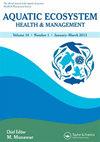Editorial
IF 0.8
4区 环境科学与生态学
Q4 ENVIRONMENTAL SCIENCES
引用次数: 0
Abstract
The story of Great Lakes protection and management can be traced as far back as the signing of Boundary Waters Treaty in 1909 between the United States and Great Britain (signed on behalf of Canada), which dealt with the principles and mechanisms of preventing and resolving disputes about water quality and quantity across the border (United States and Great Britain, 1909). The Boundary Waters Treaty resulted in the formation of an independent advisor, namely the International Joint Commission, for preventing any disputes between the two countries. More recently a binational Great Lakes Water Quality Agreement was signed in 1972 (GLWQA, 2012) between the United States and Canada (with revisions in 1978, 1987 and 2012) committing to the restoration, protection and use of an ecosystem approach (Vallentyne and Beeton, 1988; Vallentyne and Munawar, 1993). The GLWQA set water quality objectives to prevent the further pollution of boundary waters of the Great Lakes. The primary focus of the 1972 GLWQA was controlling cultural eutrophication by reducing phosphorus inputs from point and nonpoint sources. A major contribution behind the GLWQA was the excellent empirical evidence by Vollenweider et al. (1974), which indicated that cultural eutrophication was caused by excessive phosphorus loadings. The wide applicability of Vollenweider’s empirical relationships resulted in regulations for sewage treatment plants, regulations on phosphate levels in detergents, reductions in nonpoint phosphorus loadings, and establishment of total phosphorus loading reduction targets. Similar abatement actions were also implemented in European lakes (Will en, 2001). Another major scientific initiative adopted in 1985 through Canada-United States cooperation under the GLWQA, was the development of remedial action plans to restore beneficial use impairments in Areas of Concern-AOCs (IJC, 1985; 1987; Hartig and Thomas, 1988; Hartig and Vallentyne, 1989; Hartig and Zarull, 1992; Minns et al., 2011). Forty-three AOCs were identified: 12 in Canada, 26 in the United States and 5 shared bi-nationally. These restoration efforts have been underway for over 30 years, resulting in substantial progress and many ongoing challenges. In 2017, in conjunction with the 32 anniversary of the onset of remedial action plans to restore AOCs, the Aquatic Ecosystem Health & Management Society (AEHMS), International Association for Great Lakes Research (IAGLR), Great Lakes Commission, International Joint Commission, and the Detroit River International Wildlife Refuge co-sponsored a two-day symposium titled “Restoring Great Lakes Areas of Concern” at the 2017 annual IAGLR conference in Detroit, Michigan. A binational Symposium Steering Committee was established to coordinate the event. The symposium attracted a large number of delegates. Twenty-six papers, originating from both countries, were presented with a panel discussion at the end of the symposium which generated discussion about achievements, lessons learned, and the future of AOCs. The AEHMS is pleased to publish this special issue on Great Lakes AOCs. The AEHMS has a long history of publishing such special issues, including those on AOCs like the Bay of Quinte (AEHMS, 2011, 2012), Hamilton Harbour (AEHMS, 2016, 2017), and Toronto and Region (AEHMS, 2018). Keeping with this tradition, the AEHMS has organized this special issue comprised of 11编辑
大湖保护和管理的故事可以追溯到1909年美国和英国签署的《边界水域条约》(代表加拿大签署),该条约涉及防止和解决边境水质和水量争端的原则和机制(美国和大不列颠,1909年)。《边界水域条约》导致成立了一个独立顾问,即国际联合委员会,以防止两国之间发生任何争端。最近,美国和加拿大于1972年签署了一项两国五大湖水质协议(GLWQA, 2012)(在1978年、1987年和2012年进行了修订),承诺恢复、保护和使用生态系统方法(valentyne和Beeton, 1988;valentyne and Munawar, 1993)。五大湖水质谘询小组制定水质目标,以防止五大湖边界水域进一步受到污染。1972年GLWQA的主要重点是通过减少点源和非点源的磷输入来控制养殖富营养化。GLWQA背后的一个重要贡献是Vollenweider等人(1974)出色的经验证据,该证据表明,养殖富营养化是由过量的磷负荷引起的。Vollenweider的经验关系的广泛适用性导致了对污水处理厂的规定,对洗涤剂中磷酸盐水平的规定,非点式磷负荷的减少以及总磷负荷减少目标的建立。欧洲湖泊也采取了类似的减排行动(Will en, 2001年)。1985年通过加拿大-美国在《全球环境质量保证》下的合作而通过的另一项重大科学倡议是制定补救行动计划,以恢复关注领域的有益使用障碍(国际咨委会,1985年;1987;Hartig和Thomas, 1988;Hartig and valentyne, 1989;Hartig and Zarull, 1992;Minns et al., 2011)。确定了43个aoc: 12个在加拿大,26个在美国,5个在两国共享。这些修复工作已经进行了30多年,取得了实质性进展,也面临着许多持续的挑战。2017年,在密歇根州底特律市举行的2017年IAGLR年度会议上,水生生态系统健康与管理学会(AEHMS)、国际五大湖研究协会(IAGLR)、五大湖委员会、国际联合委员会和底特律河国际野生动物保护区共同主办了为期两天的研讨会,题为“恢复五大湖关注区域”。设立了一个两国专题讨论会指导委员会来协调这次活动。研讨会吸引了许多代表。来自两国的26篇论文在研讨会结束时进行了小组讨论,讨论了aoc的成就、经验教训和未来。AEHMS很高兴出版这一期关于五大湖aoc的特刊。AEHMS出版此类特刊的历史很长,包括昆特湾(AEHMS, 2011年,2012年)、汉密尔顿港(AEHMS, 2016年,2017年)和多伦多和地区(AEHMS, 2018年)等aoc的特刊。按照这一传统,AEHMS组织了这个由11个组成的特刊
本文章由计算机程序翻译,如有差异,请以英文原文为准。
求助全文
约1分钟内获得全文
求助全文
来源期刊

Aquatic Ecosystem Health & Management
环境科学-海洋与淡水生物学
CiteScore
1.70
自引率
0.00%
发文量
1
审稿时长
18-36 weeks
期刊介绍:
The journal publishes articles on the following themes and topics:
• Original articles focusing on ecosystem-based sciences, ecosystem health and management of marine and aquatic ecosystems
• Reviews, invited perspectives and keynote contributions from conferences
• Special issues on important emerging topics, themes, and ecosystems (climate change, invasive species, HABs, risk assessment, models)
 求助内容:
求助内容: 应助结果提醒方式:
应助结果提醒方式:


